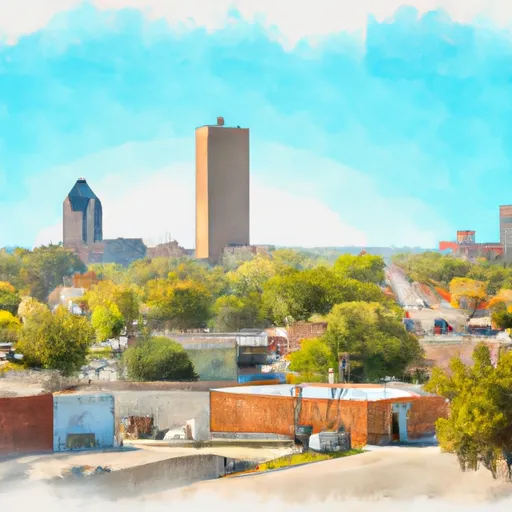-
 Snoflo Premium
Snoflo Premium
Get unlimited access to all our content
With no Ad interruptions! - Start Your Free Trial Login with existing account
Sun-City
Eden Index
Climate
8.2
•
Recreation
•
Community
•
Safeguard
3.3/10

Sun-City, Kansas is a vibrant town located in Barber County, in the central part of the state. Known for its picturesque scenery and warm community, Sun-City is a popular destination for outdoor enthusiasts.
The climate in Sun-City is characterized by hot summers and mild winters. Summers are typically dry with average temperatures ranging from 80°F to 95°F, making it an ideal time for outdoor activities like hiking, camping, and fishing. Winters are mild, with temperatures ranging from 30°F to 50°F, and occasional snowfall, providing opportunities for activities such as cross-country skiing and wildlife viewing.
Hydrology constituents play a significant role in Sun-City's outdoor recreation opportunities. The town is situated near the scenic Medicine Lodge River, which offers excellent fishing and boating opportunities. The river is abundant with various fish species, including bass, catfish, and trout, attracting anglers from all over. Additionally, the area is home to several beautiful lakes, such as Lake Coldwater and Barber State Fishing Lake, which offer swimming, boating, and picnicking.
Overall, Sun-City, Kansas provides a pleasant climate, diverse hydrology constituents, and a range of outdoor recreation opportunities for visitors and residents to enjoy throughout the year.
What is the Eden Index?
The Snoflo Eden Index serves as a comprehensive rating system for regions, evaluating their desirability through a holistic assessment of climate health, outdoor recreation opportunities, and natural disaster risk, acknowledging the profound impact of these factors on livability and well-being.
Climate Health Indicator (CHI): 8.2
Sun-City receives approximately
670mm of rain per year,
with humidity levels near 81%
and air temperatures averaging around
14°C.
Sun-City has a plant hardyness factor of
6, meaning
plants and agriculture in this region thrive during a short period during spring and early summer. Most
plants will die off during the colder winter months.
By considering the ideal temperature range, reliable water supplies, clean air, and stable seasonal rain or snowpacks, the Climate Health Indicator (CHI) underscores the significance of a healthy climate as the foundation for quality living.
A healthy climate is paramount for ensuring a high quality of life and livability in a region, fostering both physical well-being and environmental harmony. This can be characterized by ideal temperatures, reliable access to water supplies, clean air, and consistent seasonal rain or snowpacks.
Weather Forecast
Streamflow Conditions
Arkansas - Keystone
Area Rivers
Arkansas - Keystone
Snowpack Depths
Arkansas - Keystone
Reservoir Storage Capacity
Arkansas - Keystone
Groundwater Levels
Recreational Opportunity Index (ROI):
The Recreational Opportunity Index (ROI) recognizes the value of outdoor recreational options, such as parks, hiking trails, camping sites, and fishing spots, while acknowledging that climate plays a pivotal role in ensuring the comfort and consistency of these experiences.
Access to outdoor recreational opportunities, encompassing activities such as parks, hiking, camping, and fishing, is crucial for overall well-being, and the climate plays a pivotal role in enabling and enhancing these experiences, ensuring that individuals can engage in nature-based activities comfortably and consistently.
Camping Areas
| Campground | Campsites | Reservations | Toilets | Showers | Elevation |
|---|---|---|---|---|---|
| Alabaster Caverns State Park | None | 1,726 ft | |||
| Little Sahara State Park | None | 1,463 ft | |||
| Hoisington Park | 12 | 1,836 ft | |||
| Camp Pawnee | 12 | 2,028 ft |
Nearby Ski Areas
Catastrophe Safeguard Index (CSI):
The Catastrophe Safeguard Index (CSI) recognizes that natural disaster risk, encompassing floods, fires, hurricanes, and tornadoes, can drastically affect safety and the overall appeal of an area.
The level of natural disaster risk in a region significantly affects safety and the overall livability, with climate change amplifying these risks by potentially increasing the frequency and intensity of events like floods, fires, hurricanes, and tornadoes, thereby posing substantial challenges to community resilience and well-being.
Community Resilience Indicator (CRI):
The Community Resilience Indicator (CRI) recognizes that education, healthcare, and socioeconomics are crucial to the well-being of a region. The CRI acknowledges the profound impact of these elements on residents' overall quality of life. By evaluating educational resources, healthcare accessibility, and economic inclusivity, the index captures the essential aspects that contribute to a thriving community, fostering resident satisfaction, equity, and social cohesion.

